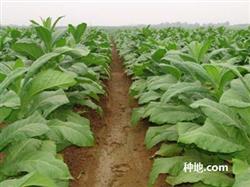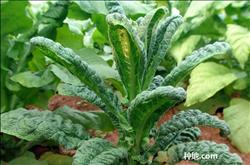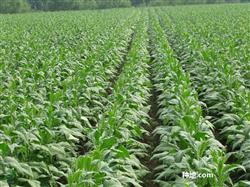How to use pesticides to grow tobacco?

How to use pesticides to grow tobacco? Pesticides have played an important role in the development of human agricultural civilization, especially in the control of dangerous and explosive diseases and insect pests. However, pesticides will cause a certain degree of pollution to the atmosphere, soil and water in the process of use, which requires the scientific use of pesticides to control pests most effectively with the least dosage, so as to obtain the maximum economic, social, ecological and environmental benefits. In view of the current situation of tobacco production in China, the Department of Science, Technology and Education of the State Tobacco Monopoly Bureau put forward a new idea of developing "pollution-free tobacco". Relying on scientific use technology can make the use of pesticides close to or achieve the effect of pollution-free. Although the development of biopesticide is in full swing, it will take time for it to be widely used in tobacco. 1. Technical parameters related to pesticide application 1. 1 semi-lethal dose (ld50) refers to the dose that causes 50% of the individual death of a certain experimental biological population. According to the hygienic toxicological grading standard of pesticides in China, rats are given oral: ld50500mg/kg belongs to low toxic pesticide, such as "Chu Yatong" raw drug ld50 is 1250mg / kg;ld50 > 2000mg/kg belongs to actual non-toxic pesticide, such as "Kebao" crude drug ld50 is 34600mg/kg to control tobacco stored pests. Ld50 reflects the harm of pesticides to the environment or human beings and animals. By improving the processing technology of dosage forms, we can achieve low toxicity of high toxic pesticides and micro toxicity of low toxic pesticides. For example, deltamethrin is the active ingredient of "Diishong", and the ld50 of "Deltamethrin" is 138.7mg/kg, which belongs to moderate toxicity. After processing into 2.5% EC, ld50 is 535mg/kg, which belongs to low toxic pesticide. The original drug of aldicarb is highly toxic, but the 15% tiomike granule commonly used to control aphids in tobacco fields (ld50 is 10.6mg/kg) is highly toxic. 1.2 half-life (dt1/2) is an index to measure the difficulty of pesticide degradation. It reflects the continuous effect of pesticides on the control of diseases and insect pests and the degree of pesticide residues. Pesticides with long half-life have a long lasting effect on diseases and insect pests and can maintain their efficacy on pests for a long time, but it is also the root cause of the formation of pesticide residues. Long pesticide residues were found in dt1/212 months. The half-life of early use of arsenic, lead and mercury preparations is as long as 10 to 30 years. The half-life of organochlorine pesticides is 2-4 years, that of organophosphorus pesticides is generally from weeks to months (the half-life of phoxim in soil is 34 days), that of carbamate pesticides is only 1-4 weeks (the half-life of aldicarb in fresh tobacco leaves is 14.4 days), and that of pyrethroids, bud inhibitors and herbicides is several days (the half-life of deltamethrin in fresh tobacco leaves is 2.1-4.2 days. The half-life of "Chiyatong" in fresh tobacco leaves is 2-4 days, and that of diachlor in fresh tobacco leaves is 3-4 days). 1.3.The maximum residue limit (mrl) is an index for standardizing pesticide residues in tobacco leaves. Even if tobacco production is carried out strictly according to good agricultural practices (good agricultural practice,gap), the active components of pesticides and their degradation products will still remain in tobacco leaves, so it is necessary to set maximum residue limits. Some farmers do not use pesticides in accordance with the recommended varieties and doses, or even use pesticides prohibited on tobacco, which may cause more serious problems of pesticide residues in tobacco. At present, the mrl index of pesticides in tobacco and tobacco products is one of the important contents for countries to control the quality of tobacco products, and it has become an important factor in the evaluation and purchase of tobacco leaves in the international market. 11 countries or regions, including the United States, Russia, Germany, France, Italy, Hungary, Spain, Croatia, Estonia, Malaysia and the Middle East, have stipulated mrl in tobacco and tobacco products. China's tobacco administrative departments have organized relevant tobacco scientific research institutions to formulate the maximum residue limits for pesticides in tobacco and tobacco products, which will be promulgated and implemented at an appropriate time in the future. two。 Technology of Scientific use of pesticides on Tobacco 2.1 selection of recommended pesticides on the basis of determining the object of control, appropriate varieties of pesticides should be selected. With different varieties and types of pesticides, their mode of action, toxicity mechanism, control objects and scope are also different, some can treat a variety of diseases or insect pests, some can only control one kind. When using a certain pesticide, we must first understand the performance and control object of the pesticide, and then prescribe the right medicine in order to achieve a good control effect. For example, internal inhalation insecticide (aldicarb) can exert its insecticidal effect only after being absorbed by tobacco plants, which is effective against piercing mouthparts pests (aphids), safe to natural enemies, and should be used according to the characteristics of internal absorption and transmission of the medicine. generally use acupoint application. In order to standardize the use of tobacco pesticides since 1999, China Tobacco production and Marketing Corporation recommended the varieties and methods of pesticides used in tobacco, and stipulated the varieties of pesticides forbidden to be used in tobacco. The recommendations for the use of tobacco pesticides in 2004 were published on October 15, 2003. 2.2 understanding the biological characteristics and damage law of the control object and comprehensively mastering the biological characteristics and damage law of the control object can provide a scientific basis for the selection of appropriate pesticides, preparation forms, use methods and the best application period. For example, there are great differences in the distribution of eggs laid by different generations on tobacco plants. In Huang-Huai tobacco area, the distribution of eggs of the second generation is relatively concentrated, mainly on the front of tender leaves, heart leaves and stems, but mainly on the front of young leaves, and the number of eggs accounts for 70% of the total eggs. At this time, a good control effect can be obtained by spraying pyrethroid pesticides 1500 times or "Wanling" 4000 times on young leaves and heart leaves. On the other hand, the egg distribution of the third generation tobacco green worm is relatively scattered, and the insect stage is irregular, so the application should be comprehensive and thoughtful. The newly hatched larvae move around day and night and feed on tender leaves. The pre-2nd instar larvae are very sensitive to pesticides, which is a good time for control. After the 3rd instar, the tobacco green worm lurks under the leaves during the day, and feeds on leaves, buds and stems at night and early morning, which needs to be applied in the evening and the application amount should be increased accordingly in order to achieve better results. According to the biological characteristics and damage law of tobacco green insects, in order to effectively control the damage of tobacco green insects, we must focus on the prevention and control of the second generation, and eliminate them before the second instar, which is both economical and effective. For example, tobacco black shank disease is a soil-borne disease, rain splash or watering spread through water flow in the growing season, the pathogen first infects the rhizome and lower leaves, and root irrigation or spraying should be used in pesticide application. However, tobacco farmers often spray the middle and upper leaves in production, which is a waste of manpower and material resources, and the control effect is not ideal. 2.3 making full use of the control threshold to select the appropriate control time and control threshold refers to the degree to which diseases and insect pests need chemical control. It is not advisable to take chemical control or to apply pesticides only when the occurrence of tobacco plant diseases and insect pests is more serious when there is a slight disease and insect damage in tobacco field. Generally speaking, the control index of aphids is 500 aphids per 100 plants, and the control index of tobacco green insects is more than 10 larvae per 100 plants. For most leaf spot diseases, chemical control is needed when the incidence rate reaches 5%, and the virus diseases can be effectively prevented by spraying before transplanting, rosette stage and early growth stage. From an economic point of view, the occurrence of diseases and insect pests in individual tobacco plants is normal, as long as the economic threshold is not reached, agricultural measures such as timely uprooting of individual tobacco plants or manual pest control are advocated. The purpose of chemical control is not only to control diseases and insect pests to the maximum, but also to ensure that the cost of control is controlled at the lowest level. The two should be fully coordinated to approach or reach the "golden combination point" of cost input and income. 2.4 fully understand the environmental factors related to pesticide application and give full play to the efficacy of pharmaceuticals to avoid drug damage and environmental pollution, which is closely related to environmental conditions. The relevant environmental conditions are mainly wind speed, rainfall, air temperature and soil. 2.4.1 Wind speed has a great influence on the effect of spraying pesticide in tobacco field, especially on small fog droplets. Excessive wind speed will lead to uneven spraying and loss of pesticides, which not only has poor efficacy, but also pollutes the environment. Practice has proved that the wind speed
- Prev

What are the conditions of tobacco deficiency?
How to control tobacco leaf curl virus disease? Tobacco leaf curl disease is also called leaf curl disease. Leaf curl is widely distributed in many tropical areas and occurs in Yunnan, Guangdong, Fujian and Taiwan tobacco areas in China. In 2006, the incidence of individual tobacco-growing areas in Yunnan was 7-11%. Leaf curl has a wide range of hosts, including plants from 14 families and 45 genera.
- Next

How to grow tobacco to withstand drought?
How to grow tobacco to withstand drought? Tobacco has higher requirements for water in the growing period, and the yield and quality of tobacco leaves will be significantly affected by drought stress. China is a country with shortage of water resources, and the temporal and spatial distribution of water resources is uneven. In recent years, some tobacco-growing areas in China have suffered from severe drought.
Related
- Fuxing push coffee new agricultural production and marketing class: lack of small-scale processing plants
- Jujube rice field leisure farm deep ploughing Yilan for five years to create a space for organic food and play
- Nongyu Farm-A trial of organic papaya for brave women with advanced technology
- Four points for attention in the prevention and control of diseases and insect pests of edible fungi
- How to add nutrient solution to Edible Fungi
- Is there any good way to control edible fungus mites?
- Open Inoculation Technology of Edible Fungi
- Is there any clever way to use fertilizer for edible fungus in winter?
- What agents are used to kill the pathogens of edible fungi in the mushroom shed?
- Rapid drying of Edible Fungi

